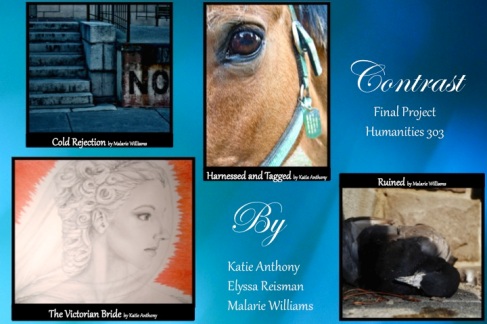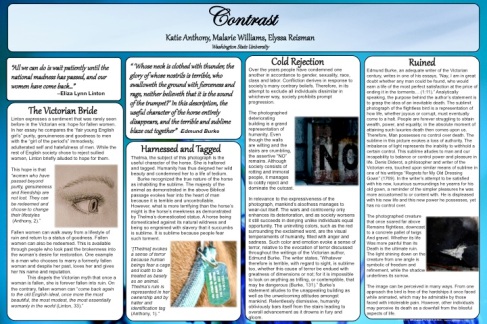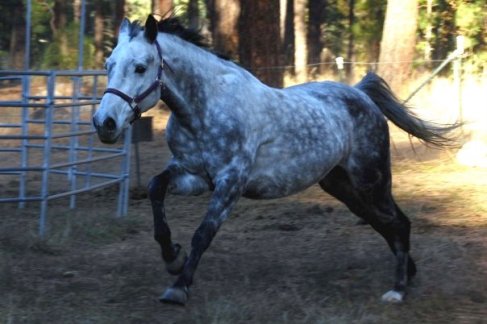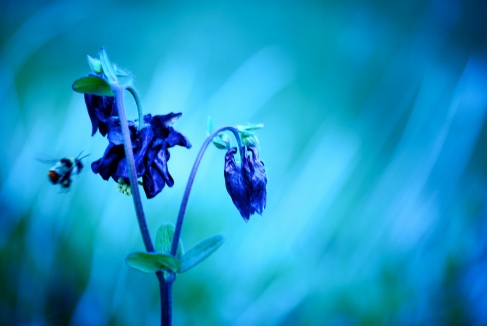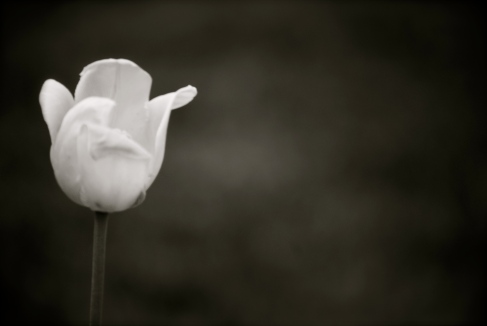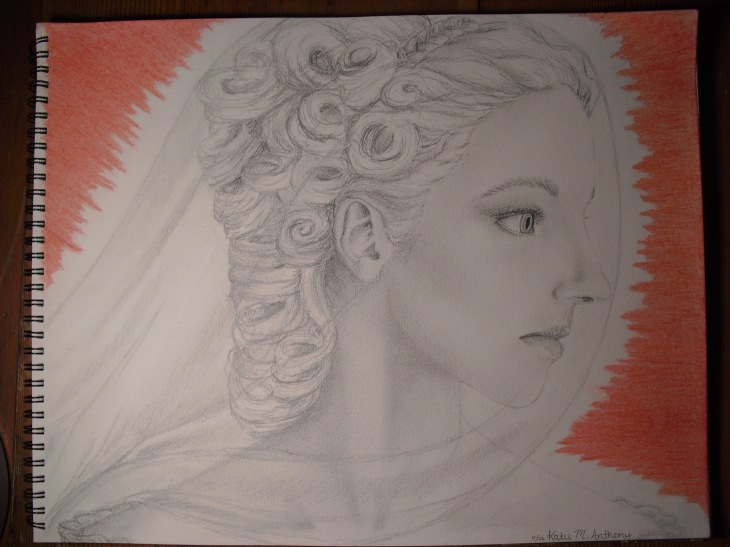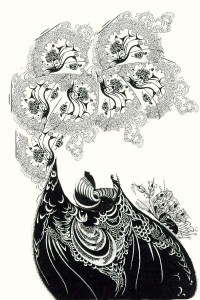Poster 1
Poster Draft
The picture of the horse represents elements of the sublime. This horse is not humble or quiet. Every muscle is taunt, its neck stretches forward, reaching for freedom. Its nostrils are flared, sucking in the air, its tail streams behind it like a victory banner. It is an epitome of youth, strength and power. Its mane is free to whip in the wind and its hooves free to leave the ground to greet the air. Each muscle of the horse’s neck, legs, flank, is defined; this horse is not a pet, or plough animal, but an athlete. Like a knight’s white courser, the horse is charging forward, eating up the ground. Its coat is smooth and sleek, and covered in dapples. Behind the horse, light blazes in the back corner, as if the horse is running from the light into the darkness. Fierce and strong, the photo captures a majestic moment of movement and strength.
After examining the work, there are several elements in this photo that make it closer to the sublime than the picturesque or the beautiful. In examining these elements it is easier to see the differences of the picturesque and sublime. Edmund Burke writes,
“let us look at [the horse], in the two distinct lights in which we may consider him. The horse in the light of an useful beast, fit for the plough, the road, the draft; in every social useful light, the horse has nothing sublime; but is it thus that we are affected with him, whose neck is clothed with thunder, the glory of whose nostrils is terrible, who swalloweth the ground with fierceness and rage, neither believeth that it is the sound of the trumpet? In this description, the useful character of the horse entirely disappears, and the terrible and sublime blaze out together” (16).
One subject, presented in two different lights, presents a viewer with two completely different images. This image is full of life, and movement and power. The horse is in full flight, and is almost idealized in the power it is able to portray. It is this power, this movement, this contrast of light and dark, that separates it from the picturesque and allows it to reach for the sublime.
The picture above was taken at dusk; the shutter speed was slow, since the adjustments of the aperture and f-stop were set to capture the blue tinge. The darkening sky meant less sunlight was able to enter the lens, which made the shutter speed slow. This produced the blurry effect of the bee’s wings, and the macro focus gave the background the blurry appearance. The flower is a wild columbine, with one open flower, and two closed buds. The blurry background draws attention directly to the flower, as it is the only thing in focus. When taking the picture, I followed the rule of thirds, and placed the subject to the side instead of the center. In order to make the picture more appealing, I waited for the bee to come to give a little more life to the picture. I also paid a lot of attention to lighting in this picture. I loved the blue color and had to take multiple pictures before capturing it. It was not edited in Photoshop, but some contrast was added to make the flower appear more sharp and crisp.
These above two images fall under the category of modern. The unique perspective on the photos is different than any of the others. In these photos, the background scenery plays almost no role except for its color or hues and to draw attention to the foreground. While the other pictures are focused on the whole, these pictures seek to draw attention to a unique perspective a single object. In society today, it is these types of works that many are drawn to.
-Elyssa
Assignment Rough-Draft
One of the following photos will be chosen for the group project, based on the overall group’s decision. The theme for this particular collection focuses on the inevitable dismissals of life. Death, rejection, hardships are all obligatory limitations that we encounter on a daily basis. The flightless bird and the blatant “NO” is a perfect portrayal of my theme. The dark colors, the concrete, and all other aspects of the photos represent the mood centered around these limitations.
As briefly explained by one of my group members in the previous blog, our fate is sometimes held captive by man. What I would like to do is hopefully combine my photos with those of my partners to imply hopefulness or some sort of positivity in the mist of darkness. I would like us to create a manifestation far beyond sadness or hardship. The point of this project is to combine different perspectives of humanity; I believe that I’ve already captured the darker parts of life and now we must bring it light
– Malarie Williams
Part of Poster assignment
These two pieces of art, photography and pencil sketch, will be displayed in our group poster project.
The picture of Thelma the horse is beautiful in form and appearance however it has darker themes behind it. The theme of encasement and smothered wildness are evident in this picture. Thelma is meant to be free and wild rather than haltered, tagged and placed in an enclosed pasture. Her fate of captivity is sublime because it strikes terror into our hearts because we also fear a cage even if that cage provides all our basic necessities.
The sketch of the bride on the other hand looks mournful but upon examination and analysis hopeful themes appear. The sketch is a personal interpretation of Linton’s essay The Girl of the Period. The essay contrasts the virtuous Victorian woman and the semi-fallen Victorian woman. However, at the end of this essay Linton suggests there is hope for fallen women. That grace and redemption by love can draw them out of their base state and into regained purity. This image of the bride is a previously fallen woman who has come out of her wild life. A man chose to love her and redeem her as she desired to repent of her formerly base lifestyle. This is her wedding day. She does not mourn for he foul days of her past but rejoices and is thankful for the grace shown to her.
These two pieces will be in conjugation with other pieces of art from my group.
–Katie Anthony
Katie’s Art Response
Katie’s Draft: Victorian Gender and Sexuality
Eliza Lynn Linton, the author of Modern Women and what is Said of Them and the passage within, The Girl of the Period had wise insight into the nature of two different kinds of women. The “fair young English girl (Linton, 26)” and the “girl of the period (Linton, 26)” are these two kinds of women. Linton portrays their characters in the words she used to describe them. In essence the “Fair young English girl” is “essentially womanly (33).” And the essence of the “Girl of the Period” is a cheap imitation of a demimonde (28). It is the contrast of moral richness and moral poverty.
Three binaries are evident in this article that contrasts the two kinds of women. There is the binary of impurity verses modesty, the binary of genuineness verses adulteration and finally the binary of Friend of men verses Foe of men.
The fair young English girl is the essence of purity in that she is “sweet, simple, restful (26) and retiring (29)”. She possesses “pretty bashful modesties and tender little ways” (32). Words like bashful, pretty and tender allude to a profound innocence possessed by this woman. The diction choice shows us that this woman is the epitome of female purity because “she is what God and nature made her to be (26).”
In contrast, the girl of the period is described as “fast and flourishing (22).” She “sacrifices decency and cleanliness (26)” in order to pursue her own “pleasure (28).” She is said to “envy of the demimonde. ” She envies the perceived high life of the prostitute with little regard for the cost. While she remains “indifferent to the sins” “she never stops to reflect (29)” on how her actions will affect her. Words such as indifference reflect and envy suggests a state of childish flippancy.
This woman “does away with moral muffishness” and “raises her [skirt] midway to her knee (27)” to show as much skin a possible without soliciting herself as an actual prostitute. She has lost her “purity of taste and delicacy of perception (28)” that is valued in women. Her main sin is that she “she acts against nature (32)” in the way she lives.
The fair young English girl is characterized as being a “genuine girl (32).” Her hair is “brown (26)” and this indicates that she has not altered her natural womanly state. The fair young English girl does not artificially change her appearance to attract attention. She is modest.
On the other hand, the girl of the period is in the business of alterations and adulterations of the natural self. She “paints her face (26),” and she “dries, frizzes, sticks out her [hair] (27).” This kind of woman modifies herself in order to attract attention, from shallow men and negative attention from decent people. The girl of the period not only adulterates herself but she is an “imitator (32).” In her lack of purity she envy’s the demimonde so much that she begins to copy the fallen woman and become a “prototype (28)” of a prostitute even though she does not actually sell her body. Because is only an imitator she is viewed by others as holding a distasteful middle ground. She is “a poor copy of the real thing (32).” She dresses, behaves and talks like a demimonde but never actually sells anything. Her worth therefore decreases in the eyes of those in the period because she lacks the virtue of the fair young English girl and the sexual promise of the demimonde.
The Fair young English girl is a friend of men and of family. She is a not “masculine of mind,” nor does she “rival” her husband in any way. Rather she is a “friend” and a “companion (25)” to her husband, his “loving (29)” support, resting place and retreat. She is a very family centered woman being a “tender mother (25), very “domestic (29) and an industrious housekeeper (25)” In today’s vernacular, housekeeper is a word describing someone who slaves away to clean and tidy. In the Victorian era and throughout a great deal of western history until very recently, being an industrious housekeeper meant being the queen of a home. This did not necessarily involve cleaning but rather, child rearing, hosting, managing people, finances and resources. Being a house keeper technically was running a business with less prestige. The fair young English girl was a woman who commanded the respect of her male counterpart. A woman of virtue “gathered around her chivalrous devotion (32).” Her virtue drew respectable men to herself. In addition “men [held] nothing so dear as the honor of the women (31)” because women had the power to destroy a man’s reputation with unsavory conduct. A woman of virtue such as the fair young English girl honored her husband or father’s reputation. The woman of virtue show that men and women were naturally “made for each other (32)” and that there is a promise of life in a marriage relationship.
On the contrary, The girl of the period is a foe of men. She is a “nuisance (27)” and “inconvenience” to men because of her love of “fun and luxury (26)” and her unquenchable “desire for money (28).” Her only intention in being connected with a man is to drain his pocket of financial wealth. She is supremely “selfish (28)” because she looks after she own pleasure and dismisses the needs of others. Her selfishness is seen most clearly in context of the home. She is “indifferent to duty.” She treats her children like a cruel “stepmother” and she is “useless at home (28).” This kind of woman is detached from the home and selfishly unwilling to engage with her children or husband. “Love is the last thing she thinks of” and she only sees a marriage as a “legal barter (30)” for the acquiring of financial funds for her own pleasure.
Because of her miserable qualities, “men are afraid of her (30).” Men project into the future what a life with her would be like and they only sport with her. She is a woman that men “flirt with but don’t marry” they “men laugh with her but they do not respect her (32).” She is a fun time that is short lived. She earns men’s disrespect with the disrespect she shows them (32) and the disrespectfulness of her lifestyle.
With these binaries in mind, the end of the passage is moving because it ignites a timeless spark of hope for both men and women in the Victorian era and today. Eliza Lynn Linton states that “all we can do [in the midst of a deprave culture] is to wait patiently until the national madness has passed, and our women have come back again to the old English ideal, once more beautiful, the most modest, the most essentially womanly in the world (32).” She states this right after presenting the fact that though the girl of the period has not fallen completely by becoming a common prostitute, she is still tainted. She is as good as fallen because her nature is scorned, undesirable and repelling. However, instead of the ending her opinion with statement of doom she concludes with a statement of hope. Women who have passed beyond purity, genuineness and friendship are not lost. They can be redeemed and choose to change their lifestyles. It is a twofold redemption. The woman is shown undeserved grace by others and she changes her lifestyle. This sentiment of grace is surprising because it is so rarely seen in Victorian literature. A Character such as Mrs. Warren in Bernard Shaw’s play Mrs. Warren’s Profession (Shaw) is an example of an unredeemed, fallen women. Another example an of unredeemed, fallen women in Victorian literature is the young girl featured in Oscar Wilde’s poem The Harlot’s House (Wilde). The fall of these women is highlighted and their shortcomings are the climax of the literature while in Linton’s essay the pseudo-fallen-ness of the girl of the period is highlighted but the hope of her redemption is the climax. It is the last thought with which Linton leaves her audience.
This counter cultural statement by Linton means grace, undeserved mercy for the Victorian women and the woman of today. In turn, this grace means hope of restoration. Forgiving the fallen women was not popular with either gender in the Victorian era but Linton’s claim that women can “come back again (32)” foreshadows a more readily extended grace in the twenty-first-century. The statement also suggests that there were cases in which parents had grace for fallen and semi-fallen daughters who were repentant of their wild living. It also suggests that there were fiancés who likewise redeemed their sullied fiancées who had chosen to forsake their former lifestyle etc.
In the twenty-first-century the social rules and regulations of women’s conduct in modern culture are much more relaxed, however, there are more or less universal boundaries for women surrounding sex, public conduct and social interactions. When women have fallen or act as fallen women today there is a often a similar disowning by family and friends that happened in the Victorian era. Linton’s claim suggesting that women can “come back again” to the “ideal,” that being purity, genuineness and companionship, is a light of hope for women today as many desire to regain lost virtue. Today, families more readily extend grace to fallen daughters and men are willing to marry and love a woman with a past, even a past of sexual sin, seeing that she was walked away from that lifestyle. In both time periods, men and women are reunited with their beloved only on the grounds of grace.
The piece of art I created to represent Linton’s essay The Girl of the Period is done though the medium of graphite pencil, colored pencil and paper. My subject is a veiled Victorian bride done up in the elegance of her wedding day. She is one of the women Linton referred to when she talked about English women returning to the ideal. This woman I created to portray one of the semi-fallen women of the Victorian era who embodied Linton’s themes of immodesty, adulteration and being a foe of men. However, this woman has been shown grace and redeemed as Linton suggested was possible, at the end of her essay. She is a bride. A man has chosen to marry and love her despite her ill reputed past. He does not see her former sin but rather the beauty that was captured through his grace and her redemption. Because of this she is portrayed in the richness of her restored purity without any hint of the poverty of her former depravity. The bride is veiled and her skin flawless, both being symbols of purity. Her eyes are downcast, not unto grief at her former wildness but rather in reverence of the grace and love that restored her to favor. Red colored pencil borders her figure. The shape of the border is drawing away from the figure. The retracting red is suggesting that the figure was once saturated with the color. Red, symbolizes the adulterous, wild and tainted woman but these attributes quickly leave her without trace of their former existence upon her. Her redemption and life change have removed the stain and left her white. In this picture she is now free from the bonds of her past and proceeding forward into new life.
Citation:
Linton, Eliza Lynn. Modern Women and What Is Said of Them: The Girl of the Period.
(25-33) Google Books. N.p., n.d. Web. 01 Nov. 2012. <http://books.google.com/books?id=YzIEAAAAYAAJ>.
Shaw, George Bernard. Mrs. Warren’s Profession. 1894. www.gutenberg.org
Wilde. Oscar. The Harlot’s House. www.victorianweb.org
Photo shop interpretation
In Aubrey Beardsley’s painting, “The Peacock Skirt”, two females are depicted in which sly, mischievous expressions are worn upon their faces. One female is garmented in what seems to be a peacock gown of some sort while the other female looks as though she’s dressed in a more raged gown. The image tells a short story. As the fancier dressed woman flaunts herself before the other she wears a grimace. The expression, in fact, takes the attention away from the feathery gown as she seems to be looking down on the girl beside her. The image somewhat alludes to the well-known fable, Cinderella, due to the idea that expense does not disguise ugliness. However, this version of Cinderella seems unlikely to conclude positively. As a flawless peacock flaunts its feathers in the distance beside the elegantly dressed woman, an arrangement of knives hang near the other female’s grasp.
My group created a new image, stealing the most precious pieces from Beardley’s painting. The idea in creating this image was to draw a new meaning to the peacock feathers. In doing so a beautiful, yet unusual, tree was formed. We used the most elegant part of the gown to form a heavy stalk while using the crown from the female’s head as a blossoming overtop. Cradled in the stalk is a form of a carriage. The newly generated image depicts a much calmer mystical tale. The symmetry throughout the image is strong, suggesting wisdom. The tree in itself is a strong form of life and the baby carriage only adds to its form.
–Malarie Williams
Baby Cradled Under Tree
Over the course of the period the class has discussed not only particular texts of different authors, but also lots of different paintings illustrated by memorable artists. Students have pulled apart these texts and paintings, unfolding their meanings and complex suggestions. Numerous individuals manage to highlight new ideas and significances behind these writings and illustrations that have been discoursed for years. Artists and writers such as Dante Gabriel Rossetti and Oscar Wilde were not randomly chosen individuals who managed to claim a title in history; they are essentialists who talentedly recorded the world around them in ways that would grab the full attention of their present audience and many more to come. These individuals subconsciously informed the world of their modern day life of which we now compare to our own. Fortunately, some of their works are past reminders of the difficulties that civilization has managed to overcome; however, other pieces are proof that some things remain unchangeable, if not worse.
A hundred years from today you are sitting in your humanities class with a hundred other students. Your teacher is discussing some sort of representation of society today. What might that representation be? Students will research a modern, or current, piece of literature, art, or any other type of media that may somewhat represent civilization today. Think of this assignment as a sort of reminder that will grab the attention of your present audience and one a century from now. Will your representation of today be a good one or a bad one? Answers will vary according to your own perspective of modern society. As the instructor, I want students to grasp the concept of the point behind discussion-based artwork and literature.
–Malarie Williams

